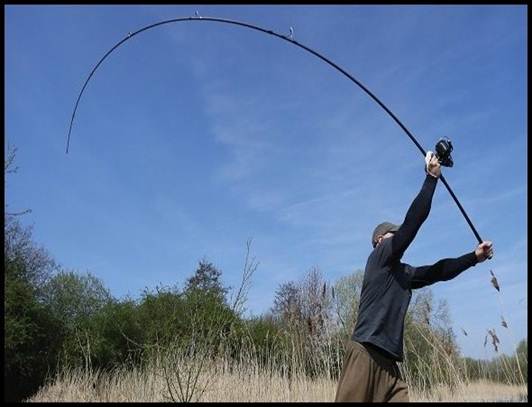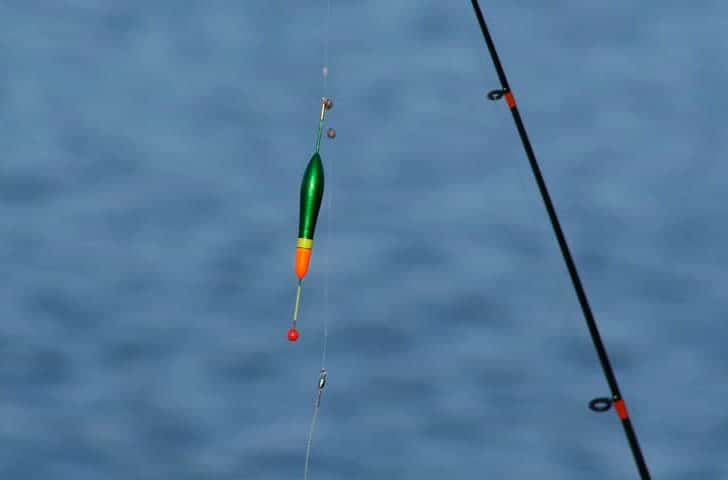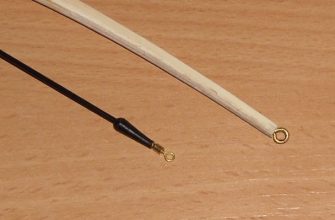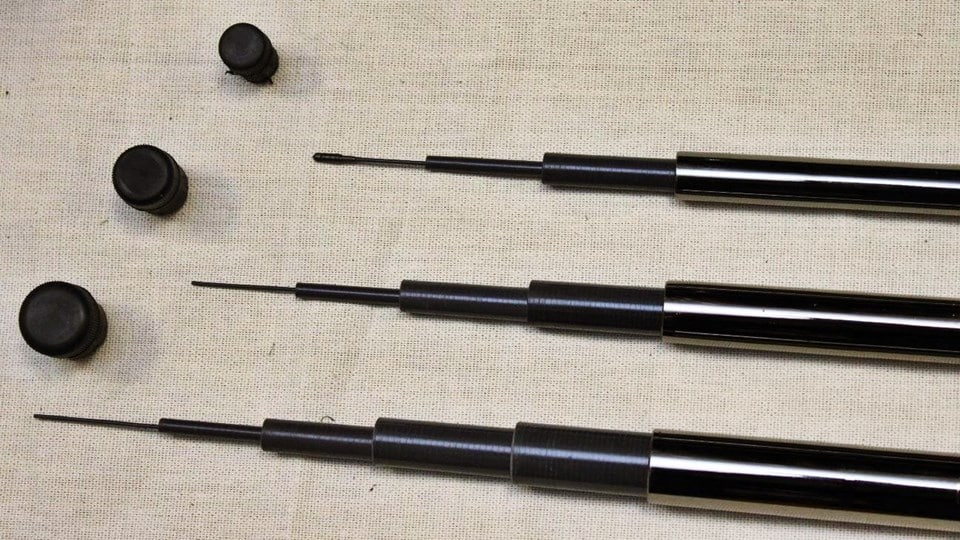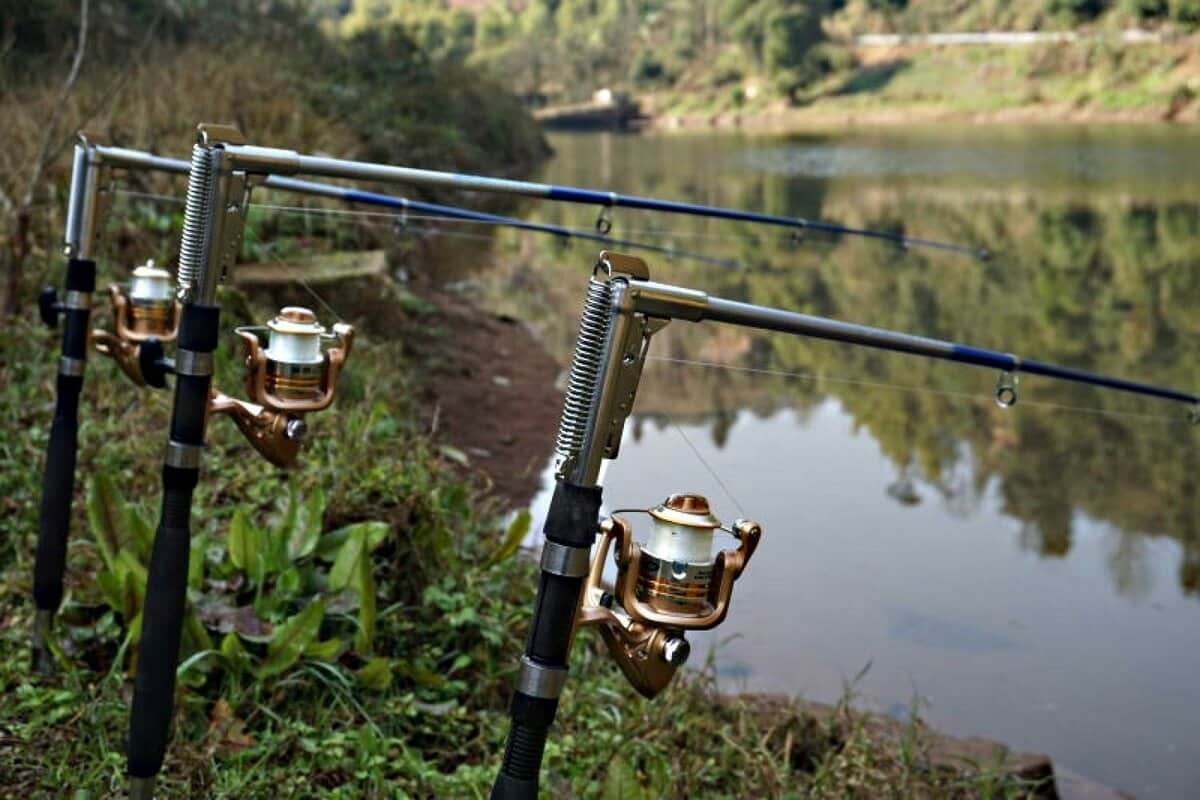What is a sliding float, equipment and installation of tackle, fastening with one point and with two points of attachment. Often, fishermen use a sliding float for fishing, which is called a running rig. This mounting option allows you to perform accurate casts over the longest distances. Below you can learn about the features of a running rig and learn how to rig a rig with a sliding float.
- What is a sliding float, the principle of operation
- How a sliding float works
- Pros and cons of sliding rigging
- When to use a sliding installation of float gear
- How to equip tackle with a sliding leash
- How to make a stop knot for a sliding float
- Tackle with a sliding float
- Sliding float rig for fishing in currents and waters without currents
- How to choose a float
- How to load the rig correctly
- How to collect tackle with a sliding float
- Match rig with sliding float
- Sliding float plug
- Features of fishing on a sliding float
- How to throw tackle
- Поделиться ссылкой:
What is a sliding float, the principle of operation
The sliding float has one or a pair of holes for fishing line, through which the float will slide. A sliding float is called a fishing installation, in which the float has the ability to move freely along the fishing line in a range limited by special stoppers. What will be the distance between the stoppers, anglers decide on their own.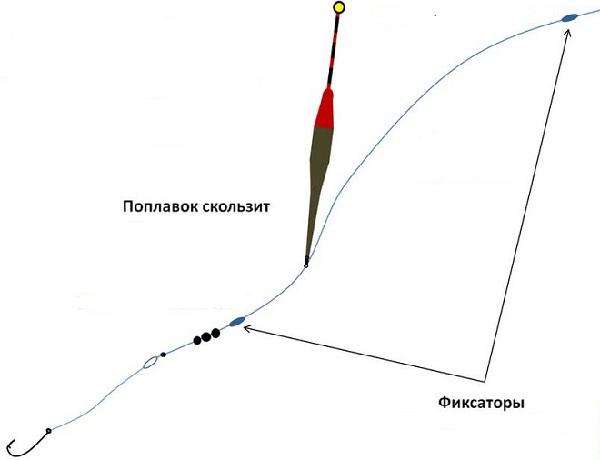
How a sliding float works
The float has one or a pair of holes for fishing line. The float can slide both along the fishing line and along it. Silicone stoppers are tightly fixed on the fishing line (one side is near the sinker, the second is where the fisherman chooses). After the float reaches the stopper, it will stop and take up its working position. How to choose a float for long casting: https://tytkleva.net/lovlya-mirnoj-ryby/poplavochnaya-snast/poplavok-dlya-dalnego-zabrosa.htm
Pros and cons of sliding rigging
A sliding bobber, like any other type of fishing rig, has both advantages and disadvantages. Among the main advantages of equipment, it is worth highlighting:
- the ability to catch a reservoir at any depth;
- performing accurate casts over the longest distances (up to 80 m);
- high float sensitivity;
- small windage;
- the ability to quickly change the float.
However, experienced fishermen warn beginners about the disadvantages of such a fishing installation. With a headwind, the float often blows to the shore. Due to the high sensitivity, it is important to ensure a rigid fixation of the gear, because any movement leads to the immersion of the float.
Note! The tip of the float is hardly noticeable at a long distance.
When to use a sliding installation of float gear
This type of installation is suitable for:
- Perform accurate casting over long distances . When you go fishing for carp/silver carp/carp, you should keep in mind that this fish is cautious and rarely comes close to the shore. At the same time, at a long distance, the fish take the bait more decisively. At the moment of casting, the float will be located near the sinker. After casting, the sinker will sink to a depth, and the float will take its working position, dropping to the second stopper.
- Implementation of fishing at depth . By installing a sliding float, the fisherman gets the opportunity to catch a section of the reservoir at any depth.
- Predator fishing on live bait . A predatory fish attacking the live bait does not feel resistance and calmly swallows the prey, securely fixing on the hook.

Advice! The top of the float should be painted in bright colors.

using a self-cutting float :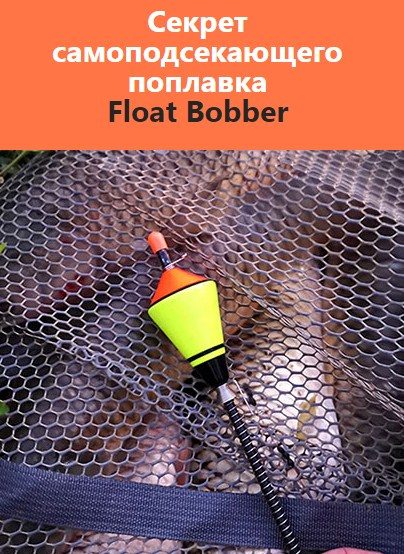
How to equip tackle with a sliding leash
Below you can get acquainted with the equipment feature of a float rod with a sliding float with two attachment points and one, learn how to choose the right float and load.
How to make a stop knot for a sliding float
Experienced fishermen advise beginners to pay attention to the fact that the stop knot not only tightly compresses the fishing line, but also moves freely along it and is compact. Step by step process:
- Stage 1. In order to tie a stop knot for a sliding float, a small part is cut off from the fishing line. The segment is folded so that one tip is a couple of cm longer than the other.
- Stage 2. The folded thread is pressed against the main cord, throwing the long tip over the fishing line and the short end. In order not to be mistaken, it is worth looking at the image, which shows how this process is correctly performed.

- Stage 3. Next, make 5 turns, heading towards the tip of the thread segment. After that, the long end is threaded into the loop and the knot is tightened. Starting to tighten the knot, it is recommended to moisten the fishing line with water. The protruding ends are cut off.

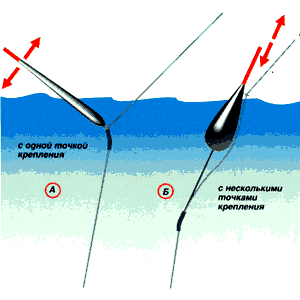
Tackle with a sliding float
For catching peaceful fish, it is advisable to mount a sliding float on a
fly /
Bologna rod. Such equipment is considered active. Thanks to the stoppers located on top of the float, you can easily change the depth. The only disadvantage of using a sliding equipment for catching peaceful fish is the lack of sensitivity. Often, fishermen who go to the reservoir to fish for predatory fish use a sliding float, which allows them to perform the most accurate casts over long distances. The predator, feeling no resistance, confidently takes the bait. The rod rigging scheme will be clear even to a beginner who is just mastering the wisdom of fishing. Looking at the image, you can independently equip a fishing rod for catching predatory fish.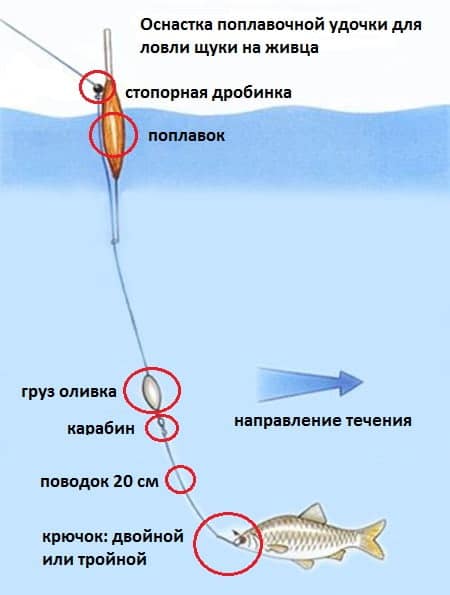
Sliding float rig for fishing in currents and waters without currents
Catching a body of water with a strong current, the fisherman needs to keep the tackle at a certain point. The total weight of the weights must be equal to the float weight. If you want to anchor the float in a strong current, it is worth using a sliding olive during installation, which will move between two stop sinkers. In this case, the fish will not feel the resistance of the olive, and the bite will be transferred to the float. When planning fishing on the current – wiring, you should ensure that the sliding float drags the load along the bottom of the reservoir, dragging it along the stream. It is recommended to use a couple of portions of shots spaced apart as weights. One is placed halfway, the other is closer to the bottom surface. For additional loading of the leash, a shed is used.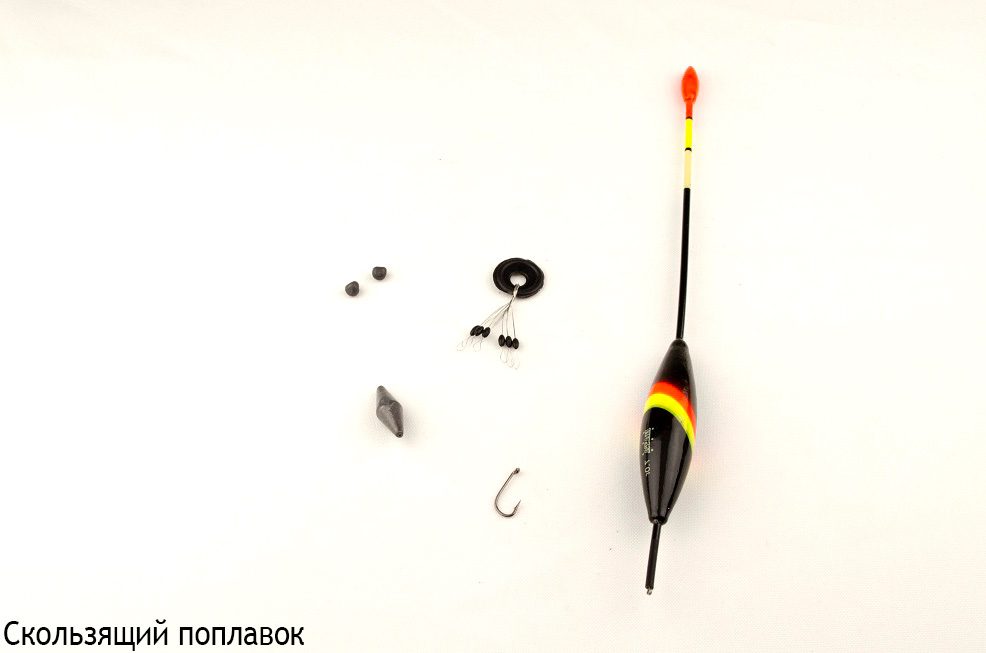
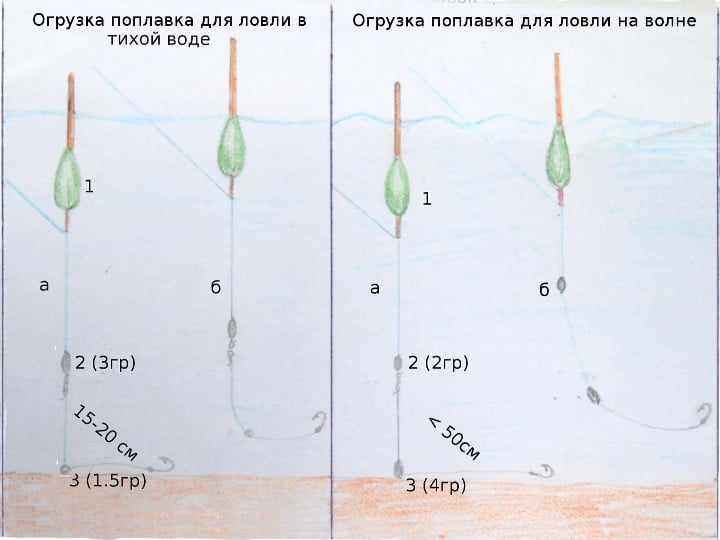
Note! When fishing in a pond with a strong current, the loads must be placed in descending order, starting from the float and leaving a couple of pellets on the lower tip of the equipment in front of the leash.
What you need to know about sliding float tackle; how to set the depth and how to catch from the bottom in the current and without it, how to make and cast a float for long casting: https://youtu.be/lUZQS_KOmvg
How to choose a float
On sale is a wide range of sliding floats, which differ in weight and shape. To cast long distances, it is advisable to use a heavier float. Manufacturers equip some floats with a weight located inside the body.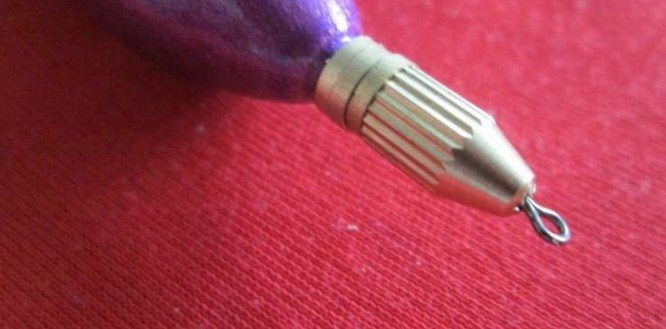
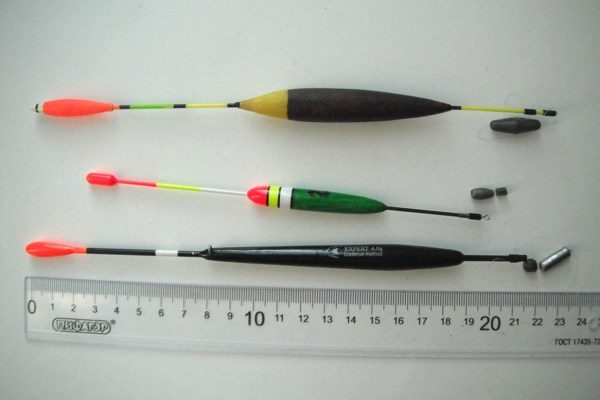
How to load the rig correctly
The sliding float is loaded depending on the fishing conditions. Quite often, fishermen prefer sinkers, the outlines of which resemble the shape of an olive. This weight comes with a bait of pellets, which, if necessary, can be used separately to make the equipment as invisible to the fish as possible. The use of single shots makes it possible to evenly distribute the mass over the equipment. However, it should be borne in mind that this method increases the likelihood of flooding.
Note! The olive weight allows you to increase the flight range of the equipment and reduce the risk of overflow.
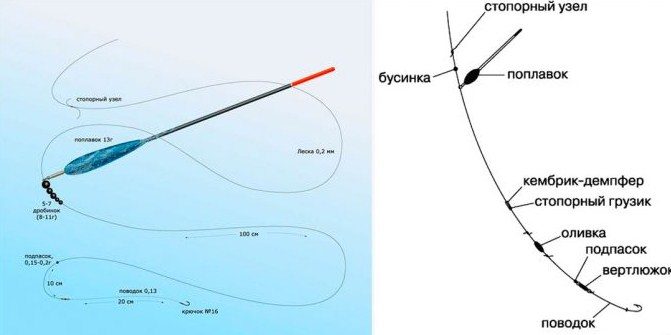
How to collect tackle with a sliding float
After reading the step-by-step guide for collecting tackle, even a novice fisherman will be able to independently cope with the process of assembling tackle.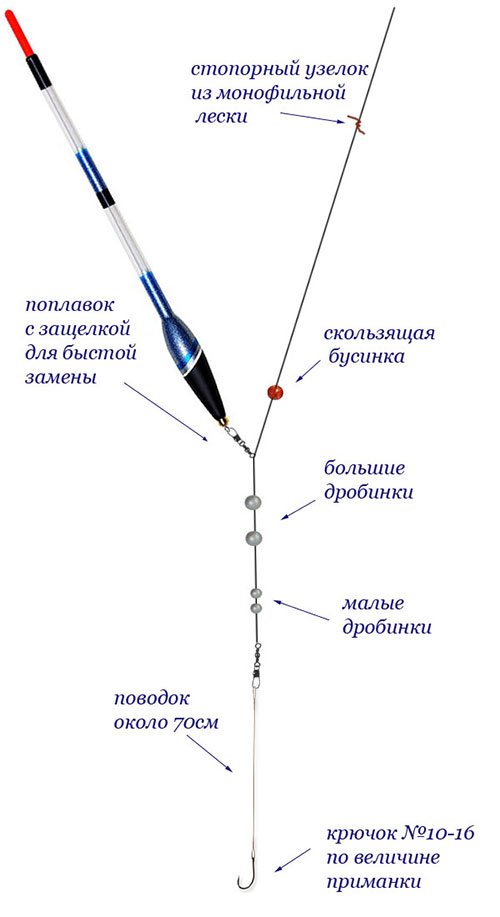
- tackle rods;
- coils of inertialess type;
- float mount;
- stoppers;
- fishing line;
- swivel and weights;
- hook leash.
A fishing line is wound on the reel and attached to the rod. The line is threaded through the through-rings. The upper stopper will act as a stopper assembly. Therefore, at the next stage, the fishermen take a piece of fishing line (18-20 cm) and apply it to the main line / line. One end of the segment is wrapped 5 times around both lines. The tip of the thread that was used to make turns is threaded into the resulting loop and tightened. Taking the float mount, the fishermen put it on the fishing line / cord. In some cases, a simple bead is placed after the stop knot and then the float itself is attached. The rubber stopper, which will act as the lower stopper, is put on the fishing line. Next, they put an olive weight, put a swivel on the tip of the fishing line and attach the leash. Note! If desired, a sliding float can be made by hand. For work, you will need to prepare a goose feather, which is first cleaned with a blade and processed from traces of feathers with sandpaper (fine-grained). The resulting float is attached to the fishing line, using a nipple for fixing. How to assemble tackle with a sliding float: https://youtu.be/_WZZBNNvmhc The main cord / fishing line is wound on the reel. Experts advise using a Below you can see the step-by-step installation process, during which anglers: Avid fishermen are advised to use monofilament fishing line, which is able to provide good glide. The carabiner, which will be located between a pair of stoppers, should be small, which will enable the fisherman to quickly change the float without disassembling all the tackle. [caption id="attachment_3371" align="aligncenter" width="710"]
Match rig with sliding float
shock leader , which should be thicker than the main fishing thread. The free end of the line passes through the leash attachment and the hole in the main weight. Rubber beads are placed on both sides of the sinker. Stepping back from the tip of the fishing line 38-40 cm, a silicone stopper is installed, which will serve as the lower stopper. Having retreated 70 cm from this point, it is worth putting on the upper stopper for the float. To the end of the main fishing thread, a leash is crocheted. After that, the equipment will need to be loaded using a set of pellets made of soft lead.
Note! It is convenient to carry out loading at the place of fishing. [caption id="attachment_5664" align="aligncenter" width="900"]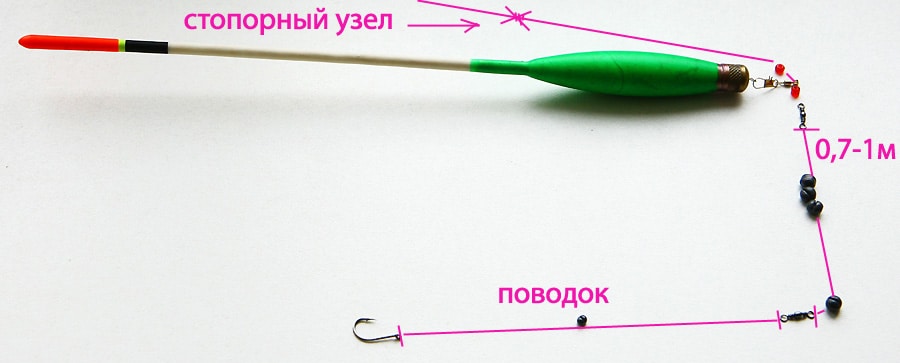
Sliding float plug
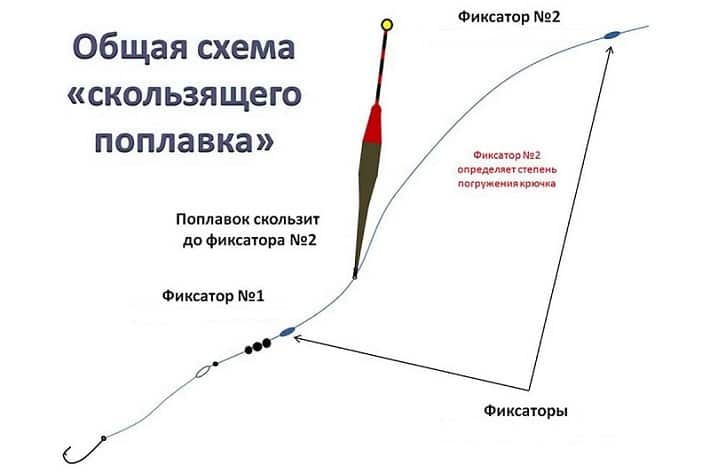
Features of fishing on a sliding float
After a promising fishing spot is found, the depth of the rig should be adjusted. To do this, perform a couple of test casts with gear adjustment. Only after that you can start bait, which can be delivered to the fishing point using a slingshot or manually. Next, the main cast is performed, during which the tackle will have to fall a couple of meters further than the fed area. It is very important to follow this recommendation so as not to scare away future prey. As soon as the equipment sinks to the bottom of the river / lake, the line is pulled up and the rod is fixed. It is also important to correctly place the tackle on the shore so that the tip of the rod is at a small angle to the direction the fishing line enters the water. The main line is pulled. When biting, the stick is taken aside with a sharp movement, not allowing the cord to loosen.
How to throw tackle
Before casting, the float is placed at a distance of 100-150 cm from the tip of the rod. You should make sure that there are no objects nearby that will interfere with the flight of the tackle. A couple of seconds before the hook with a weight falls into the water, the line is slowed down with your fingers. The equipment rushes forward.